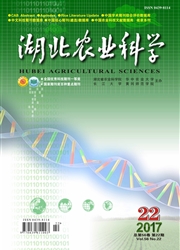

 中文摘要:
中文摘要:
对HTLV-1蛋白酶和抑制剂印地那韦的复合物进行了11 ns的分子动力学模拟,从分子整体、氢键、结合自由能及运动性等方面进行了分析。结果表明,动力学模拟使得体系更为松弛,但大部分氢键仍得到保持;疏水相互作用有利于HTLV-1蛋白酶和印地那韦的结合,关键残基主要分布在R10、L30-V39、V56-F67和W98-I1004个区域;结合自由能预测值与试验数据吻合较好。印地那韦结合仅能部分抑制HTLV-1蛋白酶的Flap、top-site以及两个exo-site位点柔性,解释了印地那韦的HIV-1 PR抑制活性为何略大于HTLV-1 PR。该研究为基于受体结构的抗HTLV-1药物研发打下了一定的结构和理论基础。
 英文摘要:
英文摘要:
One 11 ns molecular dynamics simulation(MD) for the compocind system of Human T-cell leukemia virus type 1(HTLV-1) protease(PR) and its inhibitor indinavir was performed. The mutual recognition of the two molecules was analyzed from exploring the whole molecule,hydrogen bond,binding free energy and mobility,etc.After dynamics simulation,the system keeps more relaxed compared with the crystal structure, and most of the hydrogen bonds were still maintained. Both energy decomposition and free energy calculation showed that,hydrophobic interaction facilitates the association of HTLV-1 PR and indinavir,and key residues were mainly distributed in the four regions including R10,L30-V39,V56-F67 and W98-I100.Additionally,binding free energy prediction was in good agreement with the experimental data. Indinavir can only partially attenuate the flexibility of the flap,top-site and two exo-site in the PR system,which investigated why indinavir possess more HIV-1 PR inhibition ability than that of HTLV-1 PR. The study will provide some structural and theoretical basis for antiHTLV-1 drug research based on the receptor structure.
 同期刊论文项目
同期刊论文项目
 同项目期刊论文
同项目期刊论文
 Substrate Recognition and Motion Mode Analyses of PFV Integrase in Complex with Viral DNA via Coarse
Substrate Recognition and Motion Mode Analyses of PFV Integrase in Complex with Viral DNA via Coarse Study on Molecular Recognition between Euphorbia Factor L713283 and beta-Tubulin via Molecular Simul
Study on Molecular Recognition between Euphorbia Factor L713283 and beta-Tubulin via Molecular Simul Study on the interactions between diketo-acid inhibitors and prototype foamy virus integrase-DNA com
Study on the interactions between diketo-acid inhibitors and prototype foamy virus integrase-DNA com Molecular dynamics simulations of wild type and mutants of human complement receptor 2 complexed wit
Molecular dynamics simulations of wild type and mutants of human complement receptor 2 complexed wit 3D-QSAR and Docking Modeling Study of 1,3,5-Triazine Derivatives as PSII Electron Transport Inhibito
3D-QSAR and Docking Modeling Study of 1,3,5-Triazine Derivatives as PSII Electron Transport Inhibito Molecular dynamics simulation study reveals potential substrate entry path into γ-secretase/presenil
Molecular dynamics simulation study reveals potential substrate entry path into γ-secretase/presenil Understanding peptide competitive inhibition of botulinum neurotoxin a binding to SV2 protein via mo
Understanding peptide competitive inhibition of botulinum neurotoxin a binding to SV2 protein via mo Molecular Dynamics Simulations of Ternary Complexes: Comparisons of LEAFY Protein Binding to Differe
Molecular Dynamics Simulations of Ternary Complexes: Comparisons of LEAFY Protein Binding to Differe Combined 3D-QSAR, molecular docking, and molecular dynamics study of tacrine derivatives as potentia
Combined 3D-QSAR, molecular docking, and molecular dynamics study of tacrine derivatives as potentia Molecular dynamics simulations of wild type and mutants of botulinum neurotoxin A complexed with syn
Molecular dynamics simulations of wild type and mutants of botulinum neurotoxin A complexed with syn 期刊信息
期刊信息
